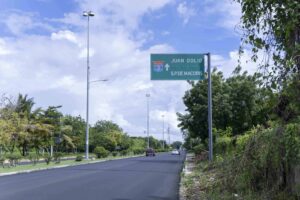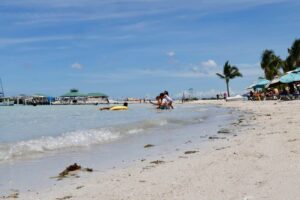Residents in the La Ciénaga neighborhood, on the banks of the Ozama Riverthey describe the Interceptor 004a type of high-tech vessel installed in 2020 to combat the pollution of waste plastics in one of the rivers most polluted in the country.
Elio Pérez (fictitious name to protect his identity) was born and raised in this neighborhood. He has dedicated much of his life to offshore fishing and is a member of the West Bank Fishermen’s Association of the Ozama River. When asked about the Interceptor’s operations, one of his companions who meets him at a fish market exclaims, “That’s a hoax!” At least five people present second it.
Perez explains that they do not understand the Interceptor’s true purpose. He assures that in the last two years they have only seen it work two or three times and, in more than four years, its use has been minimal. He points to the ramp where they take out their boats and comments that they should move the Interceptor about 50 meters upstream so as not to obstruct the exit area.
Since the installation of a mobile fence that crosses the river between both banks, fishermen have had difficulties leaving the pier. “When they close, a plug of lilacs forms that blocks our exit to the river; they should move the device higher up, where it is not in the way.”
Ocean Cleanup, the organization that manages the Interceptor, explained in May 2023, in a video posted on instagramthat, after three years of improvements, said barrier of more than 200 meters long was installed, allowing more debris to reach the Interceptor and increasing coverage from 20 to 90% of the width of the river.
The free 10% of the barrier should allow the passage of fishing boats. However, Pérez says that this is not possible since that part was not dredged, and the depth is insufficient for boats to navigate safely when there are no lilacs.
Is it really a hoax?
Rescate Ozama, a platform created in 2019 through an agreement between the Ministry of the Presidency, the United Nations Development Program (UNDP) and The Ocean Cleanup, brought the interception system to the Dominican Republic. Interceptor 004 to clean solid waste from rivers Ozama and Isabela.
This initiative also has the support of the Embassy of the Netherlands and the participation of the Technological Institute of Santo Domingo (Intec), Ecored and the Dominican Navy.
“That feeling, when you realize that this garbage will not reach the ocean thanks to the cleanup of the Interceptor 004 in the Dominican Republic,” Ocean Cleanup said on its social networks in 2020.
Rescate Ozama indicated to Diario Libre that, as of February 2024, the Interceptor 004 It has collected 239 tons of waste, although on its website it claims to have reached 270. The figure seems important, but when its efficiency is averaged, it falls far below the expectations with which it was brought to the country.
The entity considers that the community’s perception of the operation of the device is due to the fact that the operation of the Interceptor is silent and may not be perceived by the common eye.
It ensures that the barrier, installed in December 2022 and operational since January 2023, has improved waste collection, including plastics and lilacs that usually contain plastics tangled
During heavy rain, the accumulation of lilacs and debris increases, limiting the Interceptor’s effectiveness. He points out that work is being done to optimize this process. Additionally, the Interceptor’s current position was determined through bathymetry studies that identified the optimal position based on river and dredging conditions.
In 2020, Rescate Ozama reported that the Interceptor had the capacity to collect 120,000 pounds of plastic per day (about 54,000 kg), which would free the river of about 2,300 tons of garbage per year and prevent this waste from reaching the sea. However, the 270 tons collected in four years represents only 2.7% of what was expected, with a daily average of approximately 327 pounds of waste, if it had operated regularly.
“The Interceptor was out of operations during the rugged 2023 cyclone season, in which the November event (torrential rains) was notable,” argued Rescate Ozama. “After that period, in February of this year, the device was under extraordinary maintenance until the end of June, and was removed in July due to Storm Beryl, resuming operations at the end of September.”
In June 2023, Rescate Ozama reported to the press that the Interceptor had removed 220 tons from the Ozama River. This means that from that month to February 2024 it collected an average of 174 pounds per day.
He also informed Diario Libre that a waste characterization investigation developed by Intec “concluded successfully,” and the results have been published. “It is planned to provide these data to the Ministry of the Environment to support the Extended Producer Responsibility regulation,” he indicated. However, Diario Libre requested access to these studies, but it was not possible.
Manual versus technological collection
Oscar Oviedo, director of Vida Azul, an entity that has organized solid waste collection days in Santo Domingo and other locations for more than 15 years, told Diario Libre that in the last year they collected 165,345 pounds of plastics only on the beaches of Santo Domingo, in 104 days. This averages about £1,590 per day. It had been promised that the Interceptor would prevent these plastics reach the sea.
“Our opinion regarding cleaning machines rivers has always been quite clear: Having a babysitter clean a child’s room is never going to make the child learn, although the room is always kept clean, but it is thanks to the babysitter,” says Oviedo.
“Any machine that is placed in the Ozama River -he adds- it will not have sufficient capacity to prevent large quantities of plastics reach our shores. We have to focus on preventive solutions that target the root of the problem. “40 years ago you couldn’t find a dirty beach because the single-use plastic industry simply didn’t exist.”
Rescate Ozama had also said that funds would be mobilized to develop community solutions focused on waste management and plastics in the country, through the Small Grants Program (PPS-SGP), an initiative implemented by the UNDP at a global level with resources from the Global Environment Facility.



